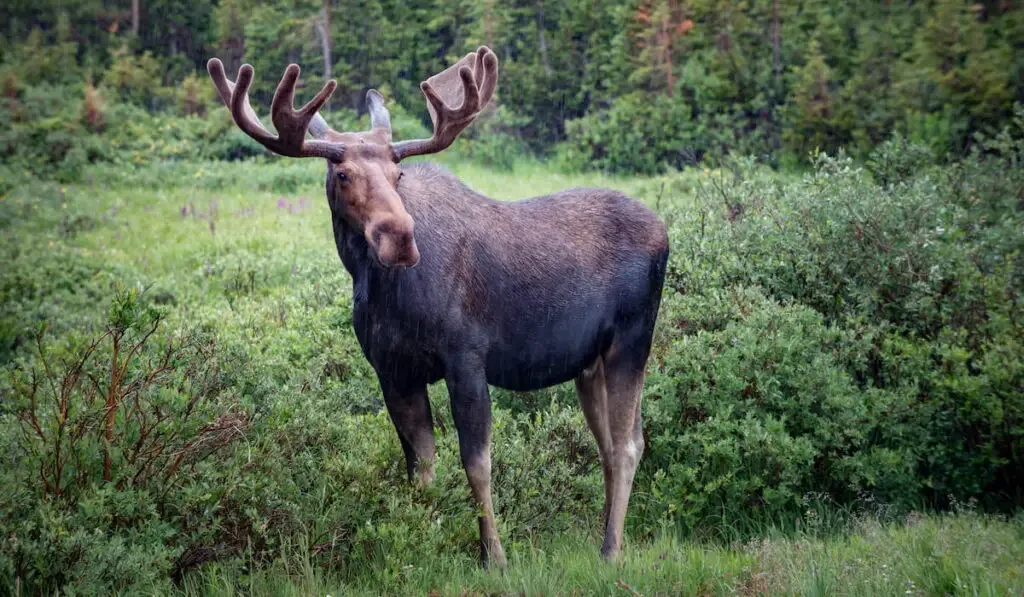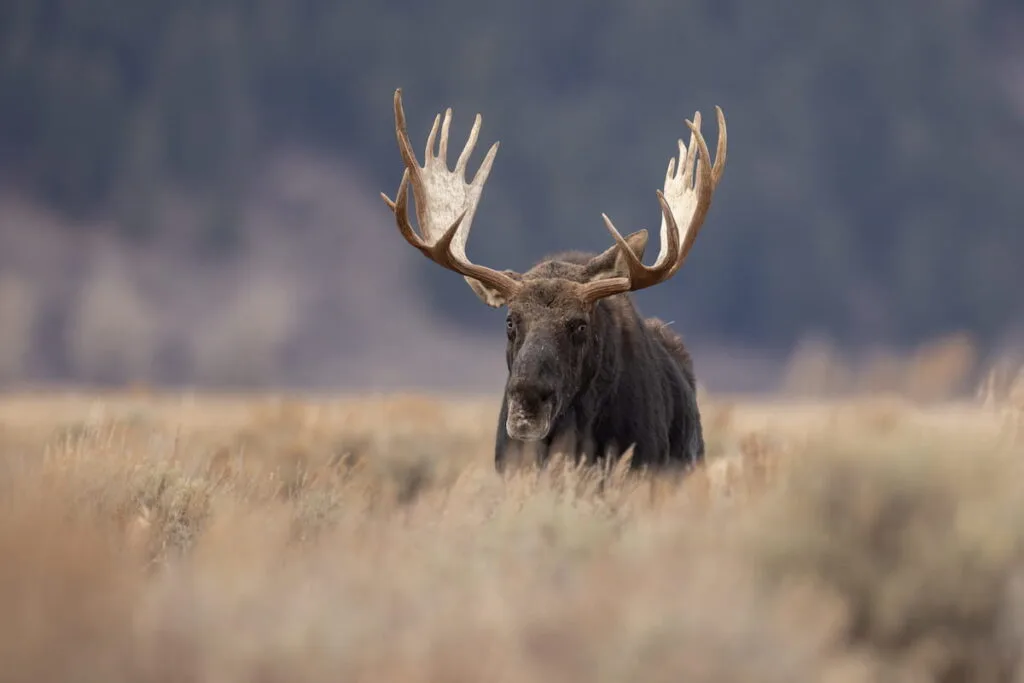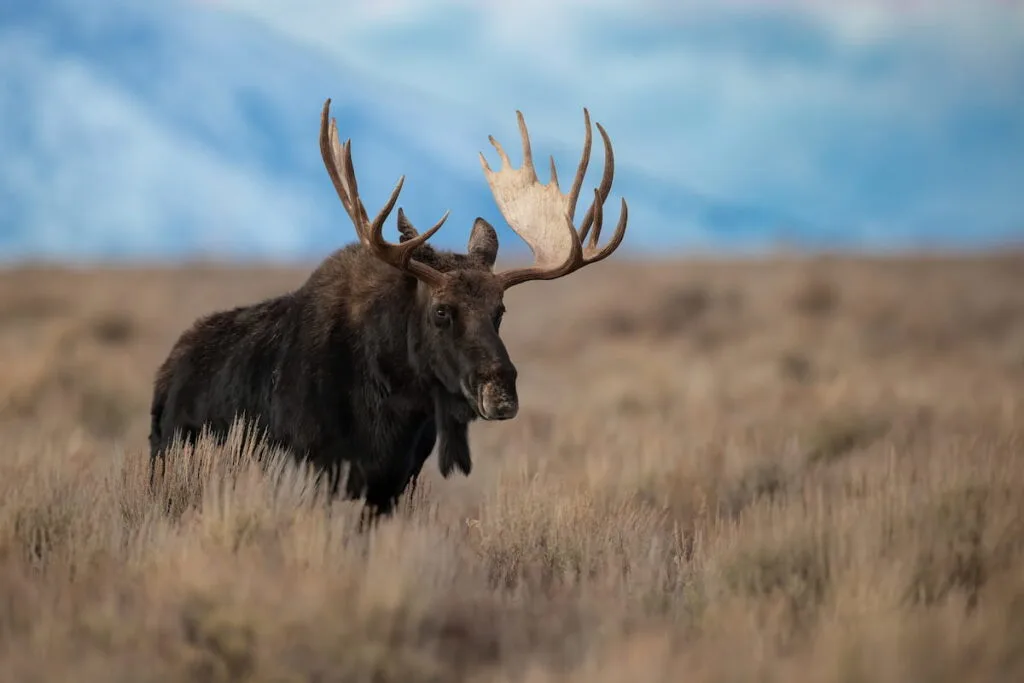Do I sense a sequel song to “What Does the Fox Say” coming out? Honestly, if you think about it, what sound comes to mind for a moose? Pondering this makes me think, what sound does a deer make?
For deer, I think nothing, but for a moose, I imagine a mix of something between a cow mooing and growling.
If you refer to references such as Brother Bear, a moose says “Take off, eh?” and “Eye spy something green and leafy…” but something tells me these are not so accurate.

Table of Contents
Let’s Get This Out of the Way: What Sound Does a Moose Make?
Ha! Tricked you! The answer is not so simple that it can be concluded in a single sentence. It, like so many other things in this world, varies and depends, based on gender and size.
That being said, out of mercy we can offer a slight straight answer. This is the most common sound a moose makes, but not the only one. Technically, no animal, including humans, makes just one sound. Our sounds vary depending on our age and gender like the moose, but also our moods and energy levels.
Animals are the same– they have feelings, and they may speak differently depending on those. This article is not about what sounds moose make when they’re sad versus happy, however. I’m unsure if anyone has measured that yet.
This article will focus on the main moose sound and all the extensions off of there. Bull moose (adult males) will make different sounds than cow moose (adult females).
Ready to learn? I thought so!
The Most Common Moose Sound
The most well-known moose sound is heard by hunters when they are out during rutting season (the season where animals in the deer family are mating, between October and early December). This is a moan.
The moaning, phonetically, would be spelled out as an “eer-ugh.” Bull moose stress the “ugh” more than the “eer,” and cow moose stress the “eer” more than the “ugh” (you, know, in case you were taking a blind test and wanted to be able to identify the gender of moose you were hearing based on their moans).
These moans are made for multiple different reasons but are mainly heard during rutting season (so I’m sure you can guess).
What Are the Bull Moose-Specific Sounds?
Understandably, bull moose are most vocal during the rutting season, when it is their time to attract a female and mate. When hunters are out hunting, it isn’t unusual for them to hear bushes shaking and lots of grunting as the males try to show off for the ladies.
The first bull moose-specific sound is a bellow. During rutting season, hunters will be able to hear these bellows cut clear through the forest, reaching over six miles away. So if you hear it, it may be close to you, or it may be six miles away.
These bellowing cries are in search of a cow moose, waiting for her to answer back with a cry of her own, or in communicating with a cow moose, possibly posing a question like “Will you marry me?” but from a respectable distance. It would probably be nice to be able to communicate with your significant other like that even six miles away– but maybe not.
Want a call that can con a moose into coming near you? Perhaps you’re a hunter and you’d like to get a moose to come to you so you don’t have to track one down yourself. This call is the most simple to imitate, and quite effective for these lonely, hopeless romantics during rutting season: a grunting croak. It sounds a little like gulping, too.

This sound is specially reserved for rutting season, and for bull moose drawing the attention of cow moose for mating.
If you make this call well, you can easily attract a cow looking for her lover (you just need to sound manly), or another bull moose ready to challenge a rival (if you sound like a weakling) depending on which you’d prefer to catch.
Now, onto warning sounds: these are ones you don’t want to imitate and should look out for as a threat if you hear a moose make them near you or especially if they make it at you. The first angry bull moose sound, during rutting season, is roaring.
The roaring can sound like an angry cow or almost like a lion, which is pretty scary. These roars are a threat to things they find dangerous, like a human, bear, or mountain lion, but also to other suitors.
A cow moose won’t deign to consider a human for a lover. These warning tones are directed at other bull moose, and effectively banish smaller bulls who can’t take a bigger one on. If a moose makes this sound at another moose, they’re ready to throw hands for their bride.
Or, if it’s making this sound at you or another predator, it’s ready to charge so watch out!
The second is the raking of a bull moose’s antlers. This, obviously, is not a vocalization, but a mix between body language and a warning sound. The bull moose accomplishes this sound by using his antlers to shake a bush aggressively.
This is a flex toward other moose bachelors in the area.
In shaking the bush with his antlers, a moose will be demonstrating the sheer size and strength of his antlers, trying to scare the other bulls out of the area and away from his bride.
This is another sound that a hunter can imitate if desiring to scare moose out of the area by sounding threatening or attracting bigger moose into the area by challenging.
If you already have moose antlers or something similar to them, you can use them to shake a bush nearby. Shake the bush for two to three seconds, and wait for a big bull moose to come strutting into the area waiting to dominate you.
The next is a sound they will make at threats outside of the moose community, regardless of whether it is rutting season, so beware of these even more.
The first is a series of short hiccupping grunts, about two or three seconds apart. It sounds a little like coughing along with hiccupping and grunting.
This sound is made when a bull moose smells something that makes it nervous, whether it knows it is dangerous or is just unfamiliar with it. It means they are apprehensive and are possibly anticipating a predator such as a hunter (you) or predators of the animal variety.
Along with the sound, the moose will have anxious body language such as lip-licking and stamping their hooves on the ground.
Remember these warning signs next time you’re out hunting, or in a moose populated area, and beware!

What Sounds Do Cow Moose Make That Can Distinguish Them From the Males?
Surprisingly, from all of the noises that the bull moose make above, the cow moose are even more vocal. They only have two distinct sounds they make, but they use them more often than the males.
Males primarily intone when they are feeling threatened, or when they are mating, but the females have males to communicate with and young to take care of, so they’ve got to do lots of talking.
Think back to the moaning from the beginning of the article. During rutting season, cow moose will make a moaning and wailing sound when she is ready to mate. That is when she can feel it in her body and hormones that her body says it’s time to breed. In making this wailing moan, she’s saying “It’s time!” and any bull moose in the area will be making their way towards her.
The moaning part of the sound is not high-pitched and is performed at a low volume. It is also short, while the wailing part is much longer, lasting approximately six to seven seconds. Phonetically, it is the “eer ugh” from the beginning, with “eer” stressed longer (the wail) and the “ugh” short and guttural (the moan).
This is a great call to imitate as a hunter, because, if done right, you’ll have the bull moose coming for you from all sides and you just have to sit back and wait.
The second sound commonly made by a cow moose is a bark. This is their own warning sound, differing from a bull moose, announcing they sense something dangerous in the area.
It differs from a male’s warning cry because it needs to show the bull moose that a lady’s in trouble (if it was another male, they’d probably ignore it) and for the calves to recognize and know it’s their mother speaking, that there’s danger nearby and they should move fast.
The sound is similar to the bark of a big dog, or the barking noise a deer makes (ah, now we know what sound a deer makes!).

